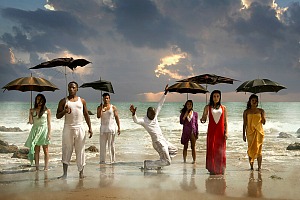The Contra-Tiempo Urban Dance Theater mission is to bring the usually unheard voices of the city onto the stage — immigrants, homeless, poor and others dealing with social disadvantage. They reach out to this non-traditional theater dance audience with engagement activities before, during and after performances. Their work brings a welcome multiculturalism into the seats, pleasing the artists and presenters and thrilling the audiences they serve.
After two years of Community Choreographic Labs that informed a slew of collaborating artists, the company premiered “Agua Furiosa” at the Glorya Kaufman Dance Theater on the UCLA campus on Jan. 14. Choreographed and directed by Anna Maria Alvarez, the 90-minute production includes eight ferocious dancers (five women, three men) and one unaccompanied jazz-style vocalist/composer, Pyeng Threadgill. The five intimately linked acts of the show give inspirational credit to sources including William Shakespeare’s “The Tempest” and Oya, the Afro-Cuban deity of wind and storms. Viewers are encouraged not to remain passive and silent during the performance, but to respond to what is seen and heard as it is happening.
With props, including almost 100 sparkling white 10-gallon plastic tubs and a black umbrella for each dancer, the non-stop action on the stage kept the eye busy. The young and strong dancers executed their almost urgent and angry phrases of movement with a commitment that underscored their deep personal connection to the themes presented — water and its relation to a host of oppressions (racism, sexism and economic inequality, among others). The aforementioned props referenced burden, shelter, guns and, perhaps unfortunately, Alvin Ailey’s iconic dance theater piece, “Revelations.” Each dancer had her or his own movement vocabulary, ranging from popping isolations for some of the men to gesture-only phrases and full-bodied modern dance. Though European ballet may have been part of some performers’ backgrounds, that genre took a back seat to what was happening in front of this audience.
A friendly game of musical stools/tubs marked the transition from one happy and cooperative group of performers to the scarcity-imposed aggression that followed. Alvarez handled the odd-person-out cleverly, until only one individual remained. In another sequence, one female dancer stood atop the pristine tubs and provocatively posed as the onlooking dancers first applauded her and then laughed and humiliated her. This traverse from good to evil came off a little arbitrarily, but that may also be the nature of the real-world experience.
Threadgill’s libretto-like, regally dressed pathway through the performing area provided an aural context for the events. Her tones often engendered hoots and hollers from the onlookers. Sound archivist d. sabela grimes amassed an interesting assortment of supportive rhythms and instrumentation, and Rosalida Medina’s otherwise streetwear-like costumes kept the time here and now. The stylistically diverse dancers were Isis Avalos, Christopher Cuenza, Jannet Goldamez, Bianca Golden, Samad Guerra, Francisco Herrejon, Bianca Medina and Diana Toledo.
The highlights for this writer were the quiet moments, when the stage was still but a slight breeze gently wafted across the upstage scrim, causing it to softly undulate. Another time, the dancers lay facedown on the floor with their hands extended to the audience. As if playing a piano or typing, a phantom rain seemed to fall over us all. A stage-crossing silhouette of one dancer walking on the backs of the others added an electrifying level change into the mix of images and physicality.
One of the goals of many artists is to make work that encourages a discussion or provokes audience members to think about what they witnessed after the event. Here’s where Contra-Tiempo’s strength lies. At the post-performance conversation, it seemed that many in the theater could identify with the scenarios demonstrated on stage. This writer was drawn to the demographic diversity in the viewership and the company’s ongoing and upcoming travels near and far. If the performing arts want to broaden their reach, will that affect the kind of work that’s created and the subjects addressed? Universal themes can often be extrapolated from idiosyncratic situations but whom will they reach?
“Agua Furiosa” will be performed again Thursday through Sunday (Thursday through Saturday shows start at 8 p.m., and the Sunday matinee begins at 4 p.m.). Feedback is welcome.
—Benn Widdey, Culture Spot LA
Glorya Kaufman Theater is located on the UCLA campus at 120 Westwood Plaza, LA 90095 (parking lot 4). Tickets are $15 to $29 and can be purchased at https://www.ticketmaster.com/venueartist/90295/2133961/&brand=capucla&camefrom=cfc_ucla_ContraEDP. For more information, visit http://cap.ucla.edu/calendar/details/agua_furiosa.






